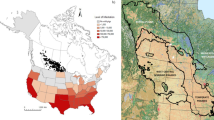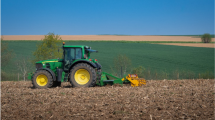Abstract
Hedgerows are an integral part of the farmed landscape and are important habitats for many birds and other wildlife. Game managers recognize the importance of hedgerows for gamebirds, both in the nesting season for wild birds and as dispersal routes from woodland release pens for reared pheasants in late summer. Conservationists are interested in the potential impacts of pheasant releasing on wildlife and habitats. The aim of this study was to assess the impact of gamebird management on hedgerow structure and the density and connectedness of hedgerows at the landscape level by comparing sites with and without gamebird releasing. We surveyed 150 sites in southern and eastern England: 97 were on pheasant shoots while the others were on farms where there had been no pheasant releasing for at least 25 years. Using a combination of field survey, satellite imagery and GIS software, we determined hedgerow abundance and their structural characteristics. We also measured the extent of hedgerow connectedness. We found that the hedgerow structure was similar on farms with and without game shoots. However, hedgebanks were between 17% and 36% wider on game estates. Game estates also had between 10% and 65% more hedgerow per square kilometre than farms with no game shoot. We found no strong evidence that game management influenced bird numbers associated with individual hedgerows. We conclude that structural characteristics of hedgerows on sites with pheasant releasing do not differ from hedgerows on farms where there is no pheasant releasing undertaken. The tendency for wider hedgebanks and greater hedgerow abundance on game estates is likely due to the recognition of game estate managers of the value of hedgerows as habitats for gamebirds. The results of this study need to be considered within the context of other studies which have highlighted the potential negative effects of large pheasant releases on hedgerow vegetation.



Similar content being viewed by others
References
Aebischer NJ, Blake KA, Boatman ND (1994) Field margins as habitat for game. In: Boatman N (ed) Field margins: integrating agriculture and conservation. British Crop Protection Council monograph No. 58, BCPC, Farnham, pp 95–104
Arnold GW (1983) The influence of ditch and hedgerow structure, length of hedgerows and area of woodland and garden on bird numbers on farmland. J Appl Ecol 20:731–750
Barr CJ, Gillespie MK (2000) Estimating hedgerow length and pattern characteristics in Great Britain using countryside survey data. J Env Manage 60:23–32
Connor HE, Draycott RAH (2010) Management strategies to conserve grey partridge Perdix perdix: the effect on other farmland birds. Aspects Appl Biol 100:359–363
Dover JW (1996) Factors affecting the distribution of satyrid butterflies on arable farmland. J Appl Ecol 33:723–734
Draycott R, Palmer J (2008) Grey partridges and land use in Norfolk. Game and Wildlife Conservation Trust Review of 2007. Game and Wildl Cons Trust Rev 39:28–29
Draycott RAH, Hoodless AN, Sage RB (2008) Effects of pheasant management on vegetation and birds in lowland woodlands. J Appl Ecol 45:334–341
Game Conservancy Trust (1991) Gamebird releasing. The Game Conservancy, Fordingbridge
Green RE, Osborne PE, Sears EJ (1994) The distribution of passerine birds in hedgerows during the breeding season in relation to characteristics of the hedgerow and adjacent farmland. J Appl Ecol 31:677–692
Hinsley SA, Bellamy PE (2000) The influence of hedgerow structure, management and landscape context on the value of hedgerows to birds: a review. J Env Manage 60:33–49
Hinsley SA, Bellamy PE, Sparks TH et al (1999) A field comparison of habitat characteristics and diversity of birds, butterflies and plants between game and non-game areas. In: Firbank LG (ed) ITE Lowland Game Shooting Study. British Association of Shooting and Conservation, pp 69–116
Hoodless A, Draycott R (2006) Effects of pheasant management at wood edges. The Game Conservancy Trust Review of 2005. Game and Wildl Cons Trust Rev 37:30–31
JNCC (2006) Biodiversity action plan: habitat action plan: ancient or species rich hedgerows. www.ukbap.org.uk/UKPlans. JNCC
Maconald DW, Johnson PJ (1995) The relationship between bird distribution and the botanical and structural characteristics of hedgerows. J Appl Ecol 32:492–505
Osborne P (1984) Bird numbers and habitat characteristics in farmland hedgerows. J Appl Ecol 21:63–82
PACEC (2006) The economic and environmental impact of sporting shooting. PACEC, London, 107 pp
Parish DMB, Sotherton NW (2004) Game crops as summer habitat for farmland songbirds in Scotland. Agric Ecosyst Environ 104:429–438
Parish T, Lakhani KH, Sparks TH (1994) Modelling the relationship between bird population variables and hedgerow and other field margin attributes. 1. Species richness of winter, summer and breeding birds. J Appl Ecol 31:764–775
Potts GR (1980) The effects of modern agriculture, nest predation and game management on the population ecology of partridges (Perdix perdix and Alectoris rufa). Adv Ecol Res 11:1–82
Rackham O (2001) Trees and woodland in the British landscape: the complete history of Britain’s trees, woods and hedgerows. Phoenix, London
Rands MRW (1987) Hedgerow management for the conservation of partridges Perdix perdix and Alectoris rufa. Biol Conserv 40:127–139
Sage RB, Ludolf IC, Robertson PA (2005) The effect of pheasant release pens on the ground flora of ancient semi-natural woodland in England. Biol Conserv 121:243–252
Sage RB, Woodburn MIA, Draycott RAH et al (2009) The flora and structure of farmland hedgerows and hedgebanks near to pheasant release pens compared with other hedgerows. Biol Conserv 142:1362–1369
Stoate C (1996) The changing face of lowland farming and wildlife. Part 2: 1945–1995. Br Wildl 7:162–172
Sutherland WJ, Armstrong-Brown S, Armsworth PR et al (2006) The identification of 100 ecological questions of high policy relevance in the UK. J Appl Ecol 43:617–627
Tapper SC (1999) A question of balance. The Game Conservancy Trust, Fordingbridge
Tapper S (2005) Nature’s gain—how gamebird management has influenced wildlife conservation. The Game Conservancy Trust, Fordingbridge
Turner C (2007) The fate and management of pheasants Phasianus colchicus released in the UK. Unpublished Ph.D. thesis, University of London, London
Acknowledgements
We thank all of the landowners, farmers and gamekeepers who allowed us access to land to survey hedgerows. We thank Neville Kingdon for GIS support and Dr. Nicholas Aebischer for advice on statistical analysis. This study was funded by The Game and Wildlife Conservation Trust. Matt Cooke was funded by grants from The Chadacre Agricultural Trust and The Felix Cobbold Trust.
Author information
Authors and Affiliations
Corresponding author
Additional information
Communicated by H. Kierdorf
Rights and permissions
About this article
Cite this article
Draycott, R.A.H., Hoodless, A.N., Cooke, M. et al. The influence of pheasant releasing and associated management on farmland hedgerows and birds in England. Eur J Wildl Res 58, 227–234 (2012). https://doi.org/10.1007/s10344-011-0568-0
Received:
Revised:
Accepted:
Published:
Issue Date:
DOI: https://doi.org/10.1007/s10344-011-0568-0




